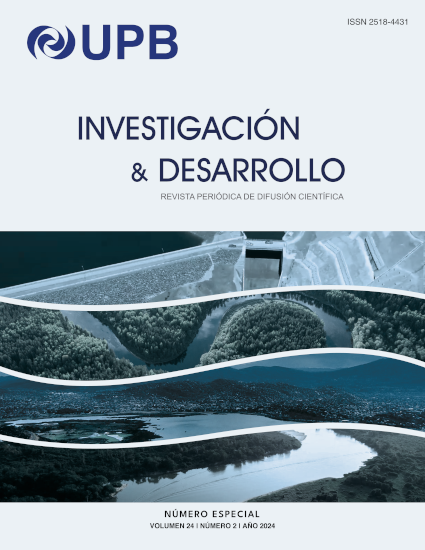ANALYSIS OF TRENDS AND EVALUATION OF PRECIPITATION BEHAVIOR IN RELATION TO THE OCCURRENCE OF DROUGHTS IN COCHABAMBA-BOLIVIA
DOI:
https://doi.org/10.23881/idupbo.024.2-3iKeywords:
Droughts in Cochabamba, Climate Variability and Oscillation, Precipitation Trend and Behavior, Precipitation Deficit, Climate TeleconnectionAbstract
During the hydrological year from August 2022 to July 2023, a notable water shortage was observed in the department of Cochabamba and in several regions of the country, which prompted the need to assess the behavior of precipitation and its trend. For this purpose, annual series of total precipitation with the most data possible were used, sourced from measurement points in the department of Cochabamba. The analysis revealed that precipitation is decreasing, primarily in the southern part of the department, in the provinces of Mizque, Campero, and the southern part of Carrasco. This phenomenon was not observed in the northern slope of the Tunari mountain range, where, on the contrary, an increase in the amount of rainfall was recorded. Additionally, it was found that the precipitation for the 2022-2023 hydrological year presents a deficit ranging from 31% to 56% of the long-term annual precipitation. To incorporate the effects of El Niño and La Niña into the study, the analysis of variability, oscillation, and trends in these cycles and their teleconnection with precipitation reveals that El Niño events may become more pronounced in the future, which negatively impacts the availability of rainwater in our region. Furthermore, we are currently in the midst of a drought cycle that could last for several more years. Therefore, it is essential to continue analyzing meteorological data to support decision-making in advance, in order to reduce the impacts of potential precipitation deficits in the future.Downloads
References
A. Gonzales, M. F. Villazon, and P. Willems, "Assessment of Rainfall Variability and Its Relationship to ENSO in a Sub-Andean Watershed in Central Bolivia," Water, vol. 10, no. 6, p. 701, May 2018, doi: 10.3390/w10060701.
J. L. Geirinhas, A. C. Russo, R. Libonati, D. G. Miralles, A. M. Ramos, L. Gimeno, and R. M. Trigo, "Combined large-scale tropical and subtropical forcing on the severe 2019–2022 drought in South America," npj Climate and Atmospheric Science, vol. 6, no. 1, p. 185, 2023.
V. Ntegeka and P. Willems, "Trends and multidecadal oscillation in extremes, based on a more than 100-year time series of 10 min rainfall intensities at Uccle, Belgium," Water Resources Research, vol. 44, no. 7, pp. 1–15, 2008.
L. Ren and X. Dong, "Spatio-Temporal Characteristics of Drought and Its Relationship with El Niño-Southern Oscillation in the Songhua River Basin from 1960 to 2019," Water, vol. 14, no. 6, p. 866, 2022.
C. A. G. Santos, D. C. dos Santos, R. M. B. Neto, G. de Oliveira, C. A. C. dos Santos, and R. M. da Silva, "Analyzing the impact of ocean-atmosphere teleconnections on rainfall variability in the Brazilian Legal Amazon via the Rainfall Anomaly Index (RAI)," Atmospheric Research, vol. 307, p. 107483, 2024.
Stockholm Environment Institute (SEI), Balance hídrico de Bolivia 1980-2020, 2023.
M. F. Villazon, "Oscillations, trends and anomalies in rainfall and air temperature in the principal cities in Bolivia," presented at the AGU Spring Meeting Abstracts, vol. 2013, pp. H52A-07, 2013.
M. F. Villazón, "Hydrodynamic Simulation Considering an Ongoing Morphological Conceptual Model for Proper Estimate of Water Levels On The River Pirai, Bolivia - Simulación Hidrodinámica Continúa Considerando Un Modelo Morfológico Conceptual Para La Correcta Estimación De Los Niveles De Agua En El Río Piraí -Bolivia," in IAHR AIIH XXVII Congreso Latinoamericano de Hidráulica, Lima, Perú, Sep. 2016.
Downloads
Additional Files
Published
Issue
Section
License
Copyright (c) 2025 Edgar Montenegro, Mauricio Villazón, Daniel Avilés

This work is licensed under a Creative Commons Attribution-NonCommercial-ShareAlike 4.0 International License.
Creative Commons Attribution-Noncommercial-Share Alike
CC BY-NC-SA
This license lets others remix, tweak, and build upon your work for non-commercial purposes, as long as they credit the author(s) and license their new creations under the identical terms.
The authors can enter additional separate contract agreements for non-exclusive distribution of the version of the article published in the magazine (for instance, they may publish it in an institutional repository or a book), subject to an acknowledgement of its initial publication in this magazine.
